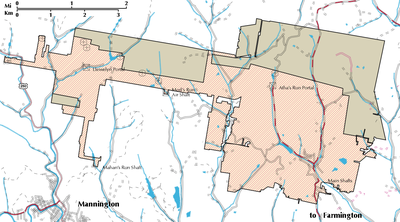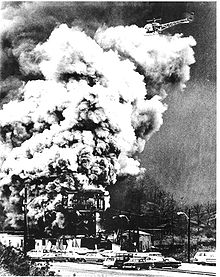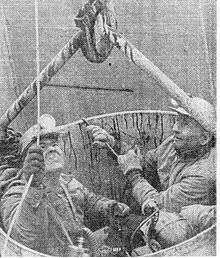- Farmington Mine disaster
-
The Farmington Mine disaster was an explosion that happened at approximately 5:30 a.m. on November 20, 1968, at the Consol No. 9 coal mine north of Farmington and Mannington, West Virginia, USA.
The explosion was large enough to be felt in Fairmont, almost 12 miles away. At the time, 99 miners were inside. Over the course of the next few hours, 21 miners were able to escape the mine, but 78 were still trapped. All who were unable to escape perished; the bodies of 19 of the dead were never recovered. The cause of the explosion was never determined, but the accident served as the catalyst for several new laws that were passed to protect miners.
Contents
Consol No 9
 Map showing location and size of the Consol. No. 9 mine and its mine shafts. Pink areas were a room and pillar mine at the time of the disaster, while retreat mining had been completed in the brown areas.
Map showing location and size of the Consol. No. 9 mine and its mine shafts. Pink areas were a room and pillar mine at the time of the disaster, while retreat mining had been completed in the brown areas.
The Consol No. 9 mine was developed in the Pittsburgh coal seam, with its main entrances at James Fork, the confluence of Little Dunkard Mill run and Dunkard Mill Run, 2 miles (3 kilometers) north of Farmington, West Virginia.(39°32′19.09″N 80°15′14.44″W / 39.5386361°N 80.2540111°W) The Pittsburgh seam, is over 300 feet (100 meters) below the valley bottoms in this region, and is fairly uniform, generally about 10 feet (3 meters) thick.
This mine was originally opened in 1909 as the Jamison No. 9 Mine, operated by the Jamison Coal and Coke Company. The original entrance shafts were 322 feet deep. Even in 1909, it was noted that "gasses are liberating" from the coal in this mine, so that locked safety lamps were used at all times. Initially, compressed air power was used to undercut the coal, which was then blasted before horse power was used to haul the coal to the shaft, but within a year, compressed air locomotives were obtained for haulage.[1]
Between 1911 and 1929, Jamison No. 9 produced over 100,000 tons per year, except in 1922, when production was just under 3000 tons. Production fell to just over 4000 tons in early 1930, after which the mine was closed for 3 years. Production resumed in 1934, climbing to over 1.2 million tons per year in 1956.[2] On Nov. 14, 1954, an explosion ripped through the mine, killing 15 miners and leading to a temporary shutdown.[3][4]
Under Consolidation Coal Company ownership, Coal production in 1977 was 98772 tons.[5]
Chronology
At 5:30 a.m on November 20, an explosion shook the mine. It was so strong that a motel clerk reported feeling vibrations 12 miles away. Miners living in the area heard the noise and, knowing what it meant, headed to the mine, where they discovered a rapidly-spreading fire with flames shooting 150 feet into the air. Within hours, 21 miners made it to the surface but 78 were still trapped underground.
The fires continued to burn for over a week, and on November 29, rescuers finally admitted defeat after air samples from drill holes showed air unable to sustain human life. The mine was sealed on November 30 with concrete to starve the fire of oxygen.
In September 1969, the mine was unsealed in an attempt to recover the miners' bodies. Progress was slow because workers discovered cave-ins that they had to tunnel around. This recovery effort continued for almost ten years. By April 1978, 59 of the 78 bodies had been recovered. Unable to recover the other 19, the mine was permanently sealed.
The actual cause of the blast and fire was never determined. However, several contributing factors were found that may have caused the blast: inadequate ventilation, inadequate control of explosive methane gas and coal dust, and inadequate testing for methane.
Aftermath
The Farmington disaster was a catalyst for the passage of major changes in the U.S. mining safety laws. One month after the Farmington disaster the U.S. Department of the Interior held a conference on mine safety. Stewart Udall's opening speech specifically referenced Farmington and concluded, "let me assure you, the people of this country no longer will accept the disgraceful health and safety record that has characterized this major industry." [6]
As a result of the Farmington disaster, the United States Congress passed the 1969 Coal Mine Safety and Health Act which strengthened safety standards, increased Federal mine inspections, and gave coal miners specific safety and health rights.
Remembering #9 - Stories from the Farmington Mine Disaster
Starting in 2008, student researchers from nearby Fairmont State University began a project to create a detailed account of the mine disaster by writing an all original play with the above title. Several students under the guidance of Director Dr. Francene Kirk (Associate professor of communication/theatre arts) spent the summer of 2008 conducting interviews and researching the disaster. During the course of the 2008-2009 academic year, the student researchers along with numerous other theatre majors at Fairmont State University began organizing all the information collected and devising a script. The play is devised as a museum theatre piece; that focuses on accuracy and informing the audience of an important historical event. Fairmont State University researchers and students have published and update frequently a wiki[1] page detailing nearly every aspect of the project. The play first premiered at Fairmont State's Wallman Hall Theatre on May 1st, 2009. During the summer of 2009, student researchers and playwrights collaborated using feedback provided from the first production and revised the script for a second running of the play, which opened September 25th, 2009. The play has received great reviews by local critics, The Kennedy Center's American College Theatre Festival and those directly involved with the disaster more than 40 years ago.
Victims
- Arthur A. Anderson Jr.
- Jack O. Armstrong*
- Thomas D. Ashcraft
- Jimmy Barr
- Orval D. Beam*
- John Joseph Bingamon*
- Thomas Boggess
- Louis S. Boros*
- Harold W. Butt
- Lee E. Carpenter
- David V. Cartwright
- William E. Currence*
- Dale E. Davis
- Albert R. DeBerry
- George O. Decker
- Howard A. Deel*
- James E. Efaw
- Joe Ferris
- Virgil "Pete" Forte*
- H. Wade Foster*
- Aulda G. Freeman Jr.*
- Robert L. Glover
- Forrest B. Goff
- John F. Gouzd
- Charles F. Hardman
- Ebert E. Hartzell
- Simon P. Hayes
- Paul F. Henderson*
- Roy F Henderson Sr.
- Steve Horvath
- Junior M. Jenkins*
- James Jones
- Pete J. Kaznoski Sr.*
- Robert D. Kerns
- Charles E. King
- James Ray Kniceley
- George R. Kovar
- David Mainella Sr.
- Walter R. Martin
- Frank Matish*
- Hartsel L. Mayle
- Dennis N. McDonald
- Emilio D. Megna*
- Jack D. Michael*
- Wayne R. Minor
- Charles E. Moody
- Paul O. Moran
- Adron W. Morris
- Joseph Muto
- Randall R. Parsons
- Raymond R. Parsons
- Nicholas Petro
- Fred Burt Rogers
- William D. Sheme
- Robert J. Sigley
- Henry J. Skarzinski
- Russell D. Snyder
- John Sopuch*
- Jerry L. Stoneking
- Harry L. Strait
- Albert Takacs
- William L. Takacs*
- Dewey Tarley
- Frank Tate, Jr.
- Goy A. Taylor
- Hoy B. Taylor
- Edwin A. Tennant*
- Homer E. Tichenor
- Dennis L. Toler
- John W. Toothman
- Gorman H. Trimble
- Roscoe M. Triplett
- William T. Walker
- James H. Walter
- Lester B. Willard
- Edward A. Williams*
- Lloyd William Wilson
- Jerry R. Yanero
An asterisk ( * ) indicates those unrecovered.
References
- ^ Annual Report, Department of Mines for the Year Ending June 30, 1910, West Virginia Department of Mines, Charlston News Mail Co, 1911. Third Section, Page 15.
- ^ Jamison C. & C. Co. Mine Data Tonnage Reports, West Virginia Office of Miners' Health Safety and Training.
- ^ West Virginia Coal Mine Disasters, West Virginia State Archives Collection.
- ^ Map Showing Extent of Forces, Flame and Deep Fire Areas, and Location of Dust Sampling Points Following Explosion, November 13, 1954, No. 9 Mine, Jamison Coal and Coke Company, Farmington West Virginia, West Virginia Mine Information Database System
- ^ Consolidation Coal Co. Mine Data Tonnage Reports, West Virginia Office of Miners' Health Safety and Training.
- ^ Lockard, Duane. Coal: A Memoir and Critique. Charlottesville, University Press of Virginia, 1998. p. 71.
External links
Categories:- 1968 disasters
- 1968 in West Virginia
- Coal mining disasters in West Virginia
- Marion County, West Virginia
Wikimedia Foundation. 2010.



